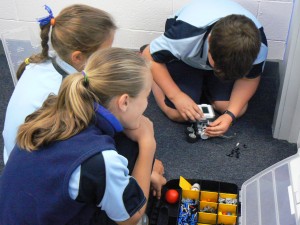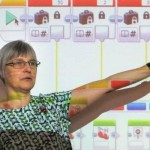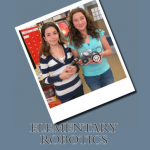
Robotics is a project-based activity that is motivating and engaging for many students. It draws on, and develops, learning related to the disciplines of science, technology, engineering and mathematics (STEM).
Background
I’m a teacher in Tasmania, Australia and have been using LEGO robotics with my students since 2001. I have mentored teams in RoboCup Junior and the FIRST Robotics Competition, and I teach an online robotics class called SmartBots. In 2010, I spent six-months based at the Tufts Center for Engineering Education and Outreach (CEEO) in Boston, USA, and continue to work closely with the Center. I am currently the Content Editor for both LEGOengineering.com and LEGOeducation.com.au.
This article was first published by the Macquarie ICT Innovations Centre.
Why teach robotics?
To be honest the main reason I started teaching robotics was because it was fun! I did, however, quickly come to the position that robotics education fosters these outcomes:
- Resilience and perseverance
- Problem-solving skills
- Communication skills
- Team work skills
- Independence
- Imagination and creativity
- Planning skills
Although robotics is by no means the only activity that can lay claim to these outcomes, it addresses them quite well and I’d wager that any robotics teacher could cite examples of how their students have developed and demonstrated these characteristics. I think all these outcomes are still fully valid, but from my time at Tufts I think I better understand what it is about robotics education that helps to bring about these outcomes.
Why do I teach robotics now?
The engineering design process – Something that became very obvious from my reading as I prepared to go to Tufts was the CEEO’s commitment to engineering education. They are explicitly committed to raising the level of engineering literacy in their broader community. They figure that the best value for effort is going to come from targeting elementary school-aged children, and that robotics is one of the approaches that they use. In fact, engineering is explicitly part of the Massachusetts K-10 curriculum and the “engineering design process” is a significant part of this. Robotics is a fun way of introducing students to the engineering design process. Here’s a version of the engineering design process that I created for use with my robotics classes:
STEM-based learning – Engineering design tasks provide a meaningful context for learning and assessing understanding in mathematics and science, so robotics is an ideal vehicle for STEM-based (Science, Technology, Engineering, and Mathematics) learning. Robotics challenges not only allow students to apply their STEM learning, but also help students to see the purpose of STEM learning.
Supply v demand – Dean Kamen, medical engineer, creator of the segway and founder of the FIRST competition, talks about the so-called “education crises” in terms of supply and demand. Politicians jump on it, and make it a divisive issue – they throw money, testing, computers at it , but does this solve it. Dean’s assertion is that it’s not an education problem – it’s a culture problem. It’s not a supply problem it’s a demand problem. What if STEM was as highly valued as sport? What if engineers were as popular as sport stars? If there was a “cricket crisis” in the US (e.g. If cricket become part of the Olympics), how would it be solved? Would it be through curriculum, standards, and national high-stakes testing, or through role models and coaching?
Challenge-based learning – Robotics lends itself to project-based learning, or at the very least challenge-based learning, and is the approach I take with all my robotics classes. Challenges can be open or closed, but my favourite challenges have a low entry with a high ceiling and allow for multiple pathways to success. I’ve been a supporter of competitions such as RoboCup Junior and FIRST LEGO League for many years, and have helped to run numerous events, but I’m starting to see the place for more theme-based or exhibition-based challenges. For example, one of the most recent challenges that I’ve been giving students is to work together to create a robotic sideshow alley. Each team is asked to design and build a robotic game that will be fun to play.
A fresh approach to learning?
I think the robotics brings a fresh perspective to the long standing tension between traditional and progressive views of education. One of the big problems in mathematics education, for example, is that because it’s so easy to create list of content of what’s in and what’s out, that it’s very tempting to think that mathematics doesn’t change, and that it’s all been solved already. This is a very insidious perspective and one that I think gets in the way of students learning to think and act like mathematicians. Imagine an art class where the students never have the opportunity to create original pieces of art work! Unfortunately maths class are too often like this…. Engineering is necessarily messy and demands creative solutions to problems. Robotics (and engineering more broadly) hasn’t been schoolified…. yet!
Rob Torok
Latest posts by Rob Torok (see all)
- Obstacle Course - 26 August 2020
- Crash Test Dummy - 26 August 2020
- The Wave - 21 May 2020
- Build X - 20 May 2020
- Build a Duck - 20 May 2020


